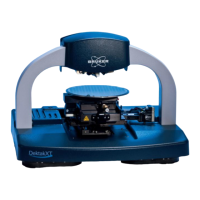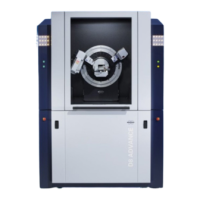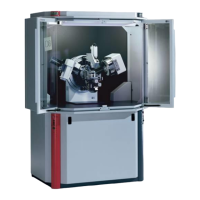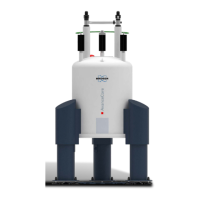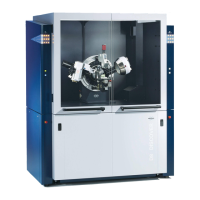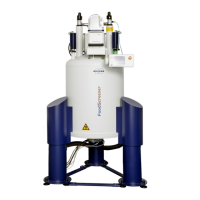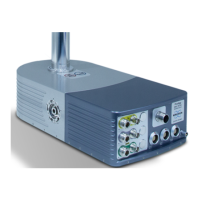User Manual D2 PHASER
DOC-M88-EXX141 V5 – 01.2015 18
2. Lower level of discriminator (LL): Signals with amplitudes lower than the LL threshold (in volts) are
suppressed and rejected.
3. Upper level of discriminator (UL): Signals with amplitudes greater than the UL (in volts) are
suppressed and rejected. Only signals with amplitudes A between LL < A < UL will be counted.
Parameters 2 and 3 have to be determined under X-ray radiation. They depend on the radiation
(wavelength) and the detector type of your D2 PHASER. The determination of the parameters may be
done using the interactive program module commander of DIFFRAC.MEASUREMENT Suite. After the
parameter determination is finished, they are stored in the configuration file on the hard disk of the
computer on which DIFFRAC.MEASUREMENT Suite runs.
Setting the discriminator window for a 1D-detector (LYNXEYE)
After alignment of the system, set the detector to an intense K
peak of a sample (preferably a peak
of your corundum sample). Set the detector to 1D-mode and open the window size to 5.5° (fig. 60).
Open the discriminator window from 0.1V to 0.5V (fig. 60) and start a measurement with fast scan
mode (corundum peak fig. 61). Read angle with max. intensity, enter it in the field ‘TwoTheta[°]
requested’, activate and press ‘go’ (fig. 62). Set scan type to ‘discriminator scan’, time to 0.5s or more
and start a discriminator scan (fig. 63). Fig. 63 shows an example of a scan. If the temperature is
stable, set the lower and upper discriminator (fig. 64) to 0.16V and 0.24V, respectively (according to
the example of fig. 63). If the temperature is not stable, use wider discriminator window settings.
Setting the discriminator window for a 0D Scintillation Counter
After alignment of the system, set the detector to an intense K
peak of a sample (preferably a peak
of your corundum sample). Start a measurement with continuous scan mode (corundum peak fig. 61).
Read angle with max. intensity, enter it in the field ‘TwoTheta[°] requested’, activate and press ‘go’ (fig.
62). Set scan type to ‘discriminator scan’, time to 0.5s or more and start a discriminator scan between
0.1V – 2.9 V. Fig. 63 shows an example of a scan with LYNXEYE and is very similar to results with SC.
Set the lower and upper discriminator limits so that the complete monochromatic peak is between the
limits.
Calibrating and setting the ROI of a 0D XFlash detector
The XFlash detector has been adjusted by factory and should be checked about once a month, due to
small long-term drifts caused by the physical principle of SDD detectors.
Calibration of the energy vs. detector channel is performed with the steel sample included in delivery:
Place the steel sample into the sample holder and insert 1mm slits into the primary and secondary
beam slit systems ((a) and (b) in fig 8, no detector receiving slit). Close the front door, switch on the
HV and start the program DIFFRAC.MEASUREMENT in order to set 2
to 80°. Then start the
program SPECTRA (for details, refer to the SPECTRA User Manual), use Menu
Measurement
Method to set the measuring time to 200s and start a measurement (
). The spectrum of the steel
sample will appear in the graphics window, containing peaks for Cr, Fe, Mn, Ni and Mo. Use Menu
Analyze
Periodic Table to display the theoretical positions of Cr, Fe, Ni and Mo in the energy
spectrum and save the spectrum (Menu
File
Save Spectrum As…) when the measurement is
finished. Use Menu
Device
Calibrate Channel/Energy to start the automatic calculation of the
calibration (fig. 66) and de-select the entry for 0keV, if included. If you want to save the new calibration,
confirm when you close the window. Additionally, you can check the resolution of the XFlash detector
with Menu
Device
Calibrate FWHM. After the system has been calibrated with the Fe K line,
you can calculate FWHM for Mn K
(fig 67). If FWHM differs by more than 10eV with respect to the
factory set value, please inform the customer service.
The region of interest (ROI) is set to the K
line of the anode material of the X-ray tube by factory and
adjusted to give an optimal signal-to-noise ratio at maximum intensity for XRD measurement. For Cu
K
the optimal range is about 300eV. The ROI only needs to be re-adjusted
if the tube has been replaced by a tube with different anode material, or
to measure diffractograms with reduced ROI, resulting in even higher signal-to-noise ratios but
lower intensity.
In order to modify the ROI of the instrument, place the corundum sample into the sample holder and
insert 1mm slits as primary and secondary beam slit systems ((a) and (b) in fig 8, no detector receiving
slit). Close the front door, switch on the HV and start the program DIFFRAC.MEASUREMENT in order
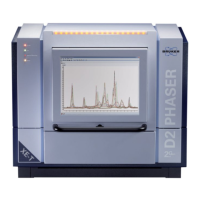
